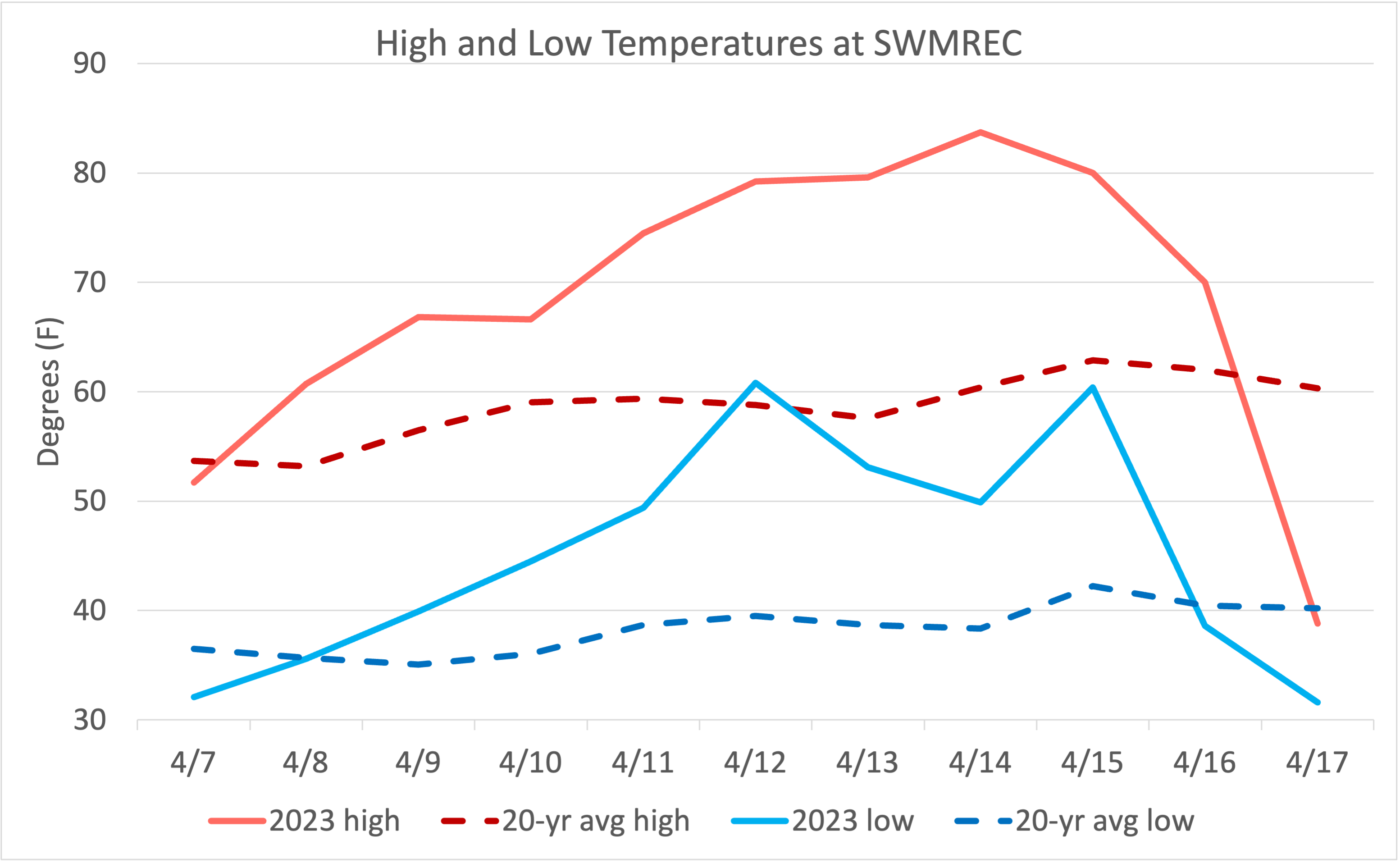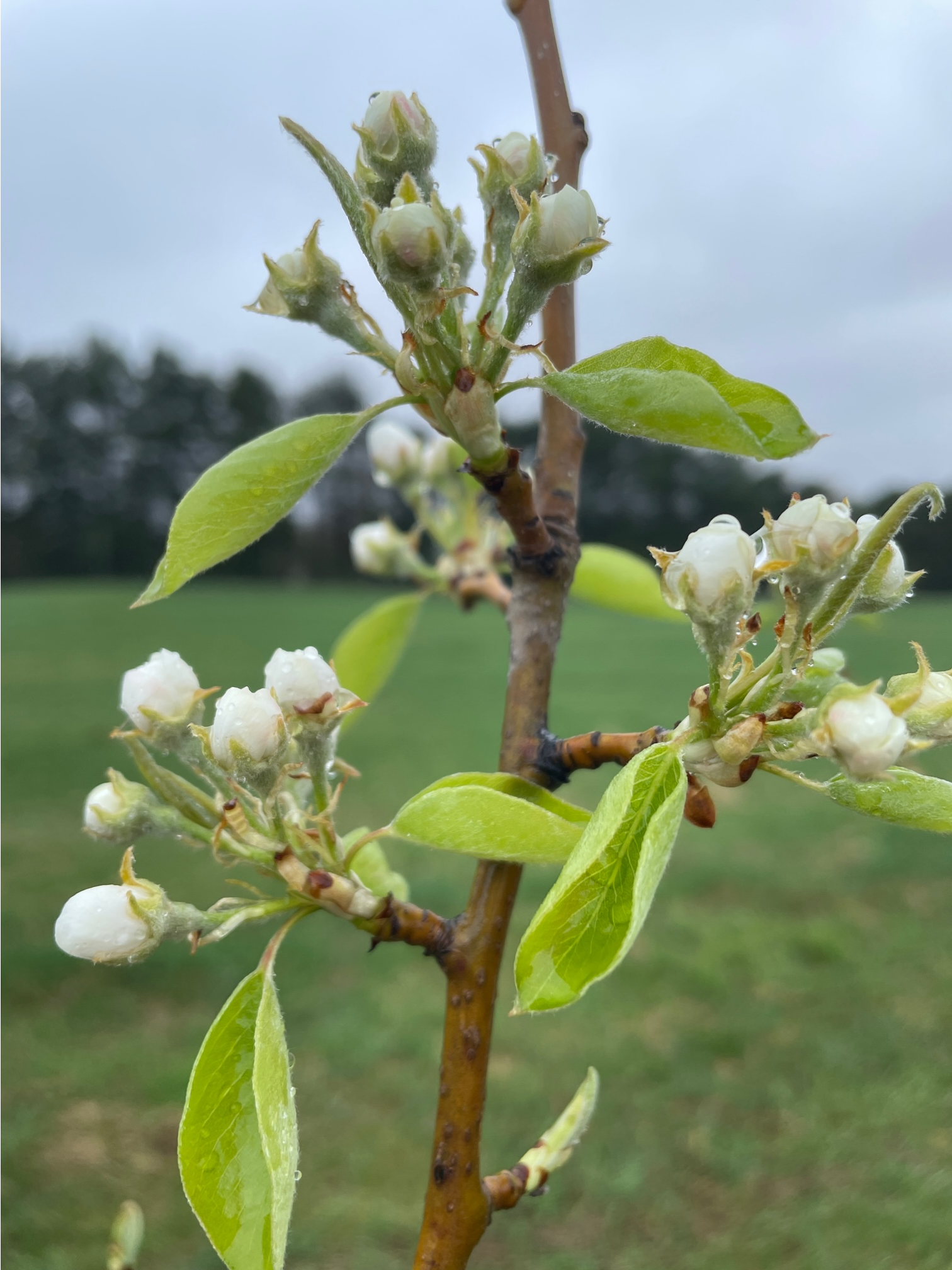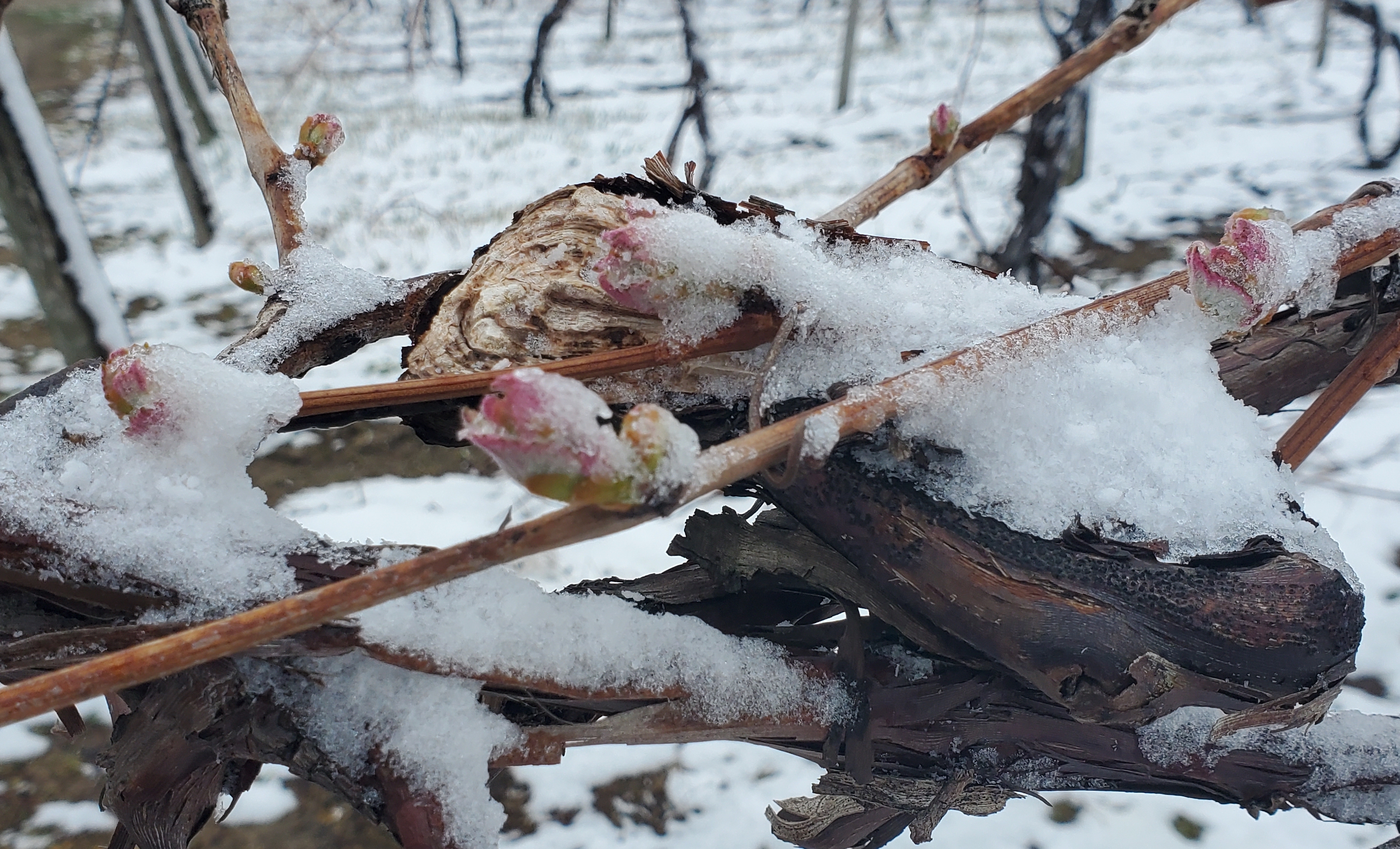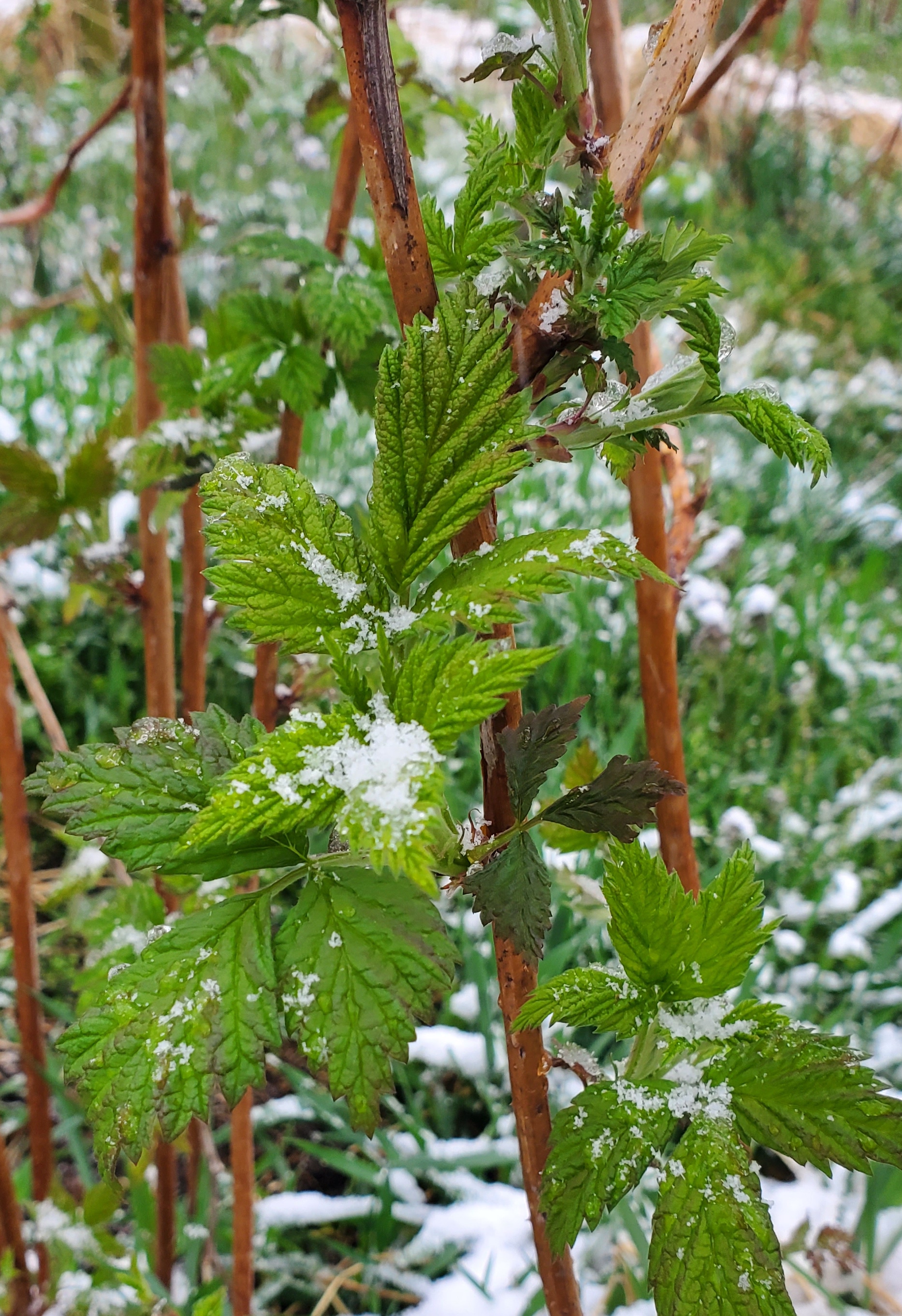Southwest Michigan fruit update – April 18, 2023
Last week’s hot weather pushed all fruit crops along quickly. Next week will be closer to normal but cool weather may be a challenge for pollinating blooming crops.

Weather
Last week was hot! Temperatures were significantly above average all week. The week started in the 70s degree Fahrenheit with Thursday, April 13, through Saturday high temperatures in the 80s F. Lows were in the 50s F or 60s F depending on the day.
A cold front entered the area on Sunday, April 16, bringing a significant cool down. Wind and rain turned to a wintery mix on Monday. Many locations saw lows on Monday morning around 30-32 F. The wind kept air mixed, so cold spots in low areas were not common. Temperatures approaching 28 F have the potential to cause some damage to blooming fruit crops, with significant damage in the mid to low 20s F. We do not expect to see significant damage from the cold weather on Monday and Tuesday.
The region saw a lot of growing degree days (GDD) last week, 136 GDD base 42 and 91 GDD base 50, respectively. Those numbers more closely match an average week in early June. We went from a week behind average to a week ahead.
|
Southwest Michigan GDD summary from March 1 – April 17, 2023 |
|||
|
Station |
GDD 42 F |
GDD 45 F |
GDD 50 F |
|
Benton Harbor (SWMREC) |
250 |
196 |
132 |
|
Lawton (Lawton) |
246 |
193 |
132 |
|
Fennville (TNRC) |
206 |
159 |
105 |
|
Average for the SW region |
239 |
186 |
125 |
|
Average last week |
103 |
68 |
34 |

The next week to 10 days should see significant swings back and forth between seasonal weather and cool periods. Most days have a significant chance of rain this coming week as well. The coldest mornings are likely to be Wednesday and Sunday or Monday where we should see temperatures in the low 30s F. Depending on wind conditions, inversions are a possibility.
Tree fruit
Temperatures in the 60s F to 80s F last week jumped peaches, cherries, plums, pears into bloom in central Berrien County. Development was slowed on the weekend by temperatures in the 30s F, but the low temperatures were generally not harmful to fruit crop prospects for 2023. Fruit bud longevity waiting for good pollination conditions is a concern. See the article “What can fruit growers do if a freeze is coming?” from Michigan State University Extension for more information.
The combination of recent rain and snow has replenished dry soils. Oriental fruit moth flight is expected for the area when warm temperatures resume. Tarnished plant bug was detected in fruit trees during warm weather last week. Plum curculio will be a concern when evening temperatures start to climb. Limited bee activity was detected in stone fruit.
Apricots and aprium fruit buds are at full bloom to fruit in the shuck. Crop prospects are still good.
Peach and nectarine are at first to full bloom. Fungicides for brown rot management start in bloom. Recent cold temperatures have temporarily halted oriental fruit moth flight and mating. The need for bacterial spot management generally becomes more important after bloom to protect leaves. See the MSU Extension Fruit Management Guide for information on copper rates and other chemical options.
Cherries are at early bloom for Montmorency tart cherry and full bloom for sweet cherry in Berrien County. Fungicide coverage for brown rot and cherry leaf spot are the primary concerns.
In plums, Japanese and European plums are in bloom in central Berrien County. Disease coverage concerns are both black knot and brown rot.
Apple early blooming varieties Zestar, IdaRed and Macintosh are at pink in Berrien County, with other varieties in tight to open cluster. Disease management concerns are scab, powdery mildew and rust. Using copper fungicides can cause damage to green tissue after tight cluster. Protectants are preferred over systemic fungicides at this time of year for scab control. Scab infections require long wetting periods (40 hours or more) when temperatures are close to freezing.
Pear (Bartlett) is beginning to bloom in the south end of the region. Scab and pear psylla management are the major concerns.

Small fruit
Grapes have moved significantly in the last week. Most grape varieties are at or past early bud swell. Juice grapes and early hybrids are at full bud break with first leaves starting to fold out. Other hybrids and early vinifera varieties have opened up, but leaf material is not yet visible. Dormant pruning should be ending.

The disease focus at this time is on phomopsis, black rot, anthracnose and powdery mildew. With the mild winter, expect high levels of surviving inoculum on shoots, dried clusters and canes. A dormant spray in the fall or spring can help manage them before the season starts. Once leaf tissue is visible, contact fungicides that include broad-spectrum or contact fungicides like the EBDCs (FRAC M3) and captan are effective and function similar to dormant applications by sanitizing the vineyard before bloom. Organic growers can use early season oils, which try to suffocate overwintering fungal spores and infected tissues. Be careful of utilizing oil applications within 14 days of any sulfur application due to phytotoxicity issues.
Blueberry leaf buds have opened. One to two leaves are visible. Fruit buds are separating. The window for application of copper, Sulforix or lime sulfur products to suppress early season diseases is closing. Be prepared to start scouting for mummy berry soon. As leaves expand, mummy berry and phomopsis shoot strikes are the main disease focus at this time.
Strawberries have greened up and new leaves are starting to emerge from the crown. Early sites where strawberries are being grown on plastic mulch are more advanced. Some blooms have been seen in those situations. With the cool weather expected this next week, floating row covers or other protection may be needed if frost conditions develop. Growers are looking at early season herbicides to control overwintering weeds. When selecting an herbicide, make sure and check the pre-harvest interval (PHI). We are getting to the part of spring where some herbicide PHIs are cutting it close to predicted harvest dates.
Brambles: Buds have separated from the cane and are starting to open. Some early varieties have expanded leaves. Lime sulfur treatments for anthracnose can still be applied to late bud break varieties, but phytotoxicity becomes a concern when green tissue is present.

Currants and gooseberries continue to green up. Currants are blooming. Gooseberries will be blooming soon. During bloom, avoid spraying pesticides to protect pollinators.
Hops have started to move. Bines up to 2 feet long have been observed. These first bines will be mowed or removed by herbicide. The resulting new bines will be more productive than these early shoots.
Announcements
Our regular southwest Monday fruit IPM updates are once again a hybrid format. The meetings are held in-person with virtual attending also available online. Our first meeting was Monday, April 10, at 5:30 p.m. and will continue through the rest of the season. You need to register to receive the Zoom link and password for these meetings. The webinars are free and one pesticide applicator credit is available for each meeting. The same Zoom link will be used with all the Monday meetings—you only need to register once. Before the meetings, Cheyenne Sloan will have Fruit Spray Guides for sale on April 21 and will have forms available for tax-exempt individuals for receiving a reduced price.
Derek Plotkowski, the fruit educator in southeast Michigan, is organizing an Orchard and Fruit Production Classifieds & Exchanges service. Looking for something that you can’t get ahold of in time? Maybe one of your neighbors has some on hand. Have extra of something you’d like to offer? Fill out this form and we’ll add your needed or extra items to the Orchard Classifieds/Exchanges list. The items currently on the exchange can be found here: Orchard Classifieds and Exchanges.
This work is supported by the Crop Protection and Pest Management Program [grant no 2021-70006-35450] from the USDA National Institute of Food and Agriculture. Any opinions, findings, conclusions, or recommendations expressed in this publication are those of the author(s) and do not necessarily reflect the view of the U.S. Department of Agriculture.



 Print
Print Email
Email
